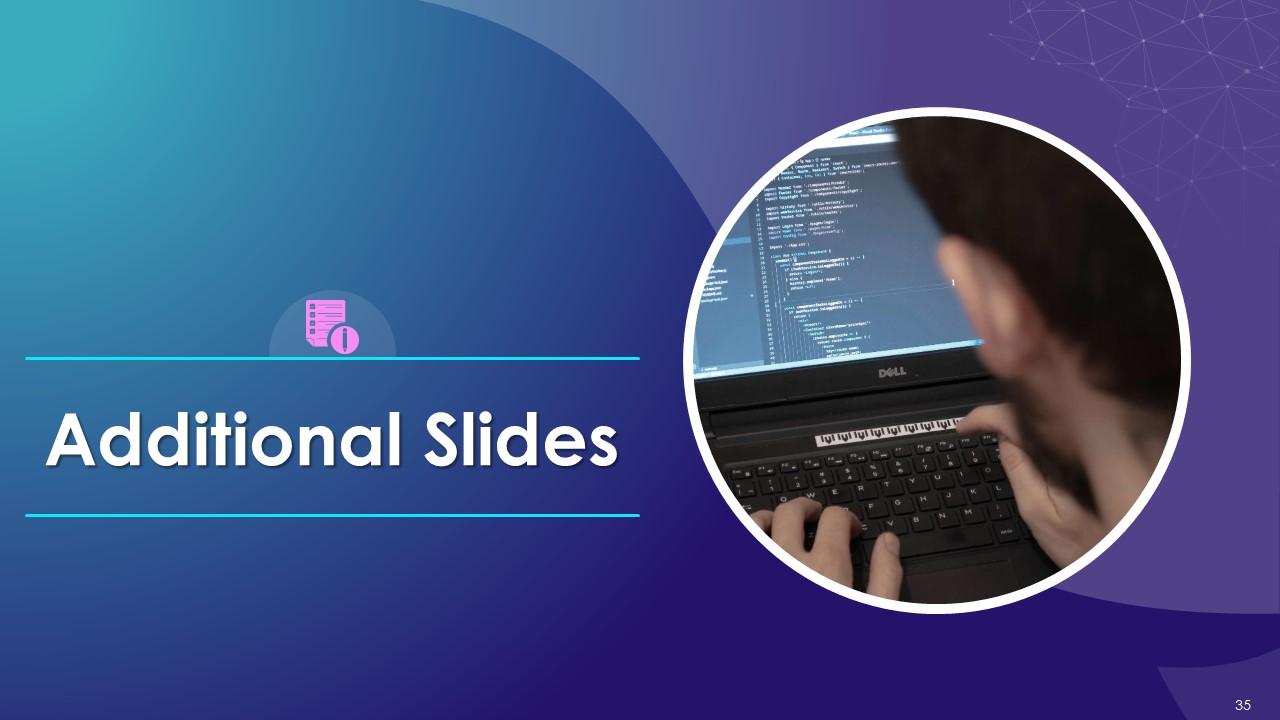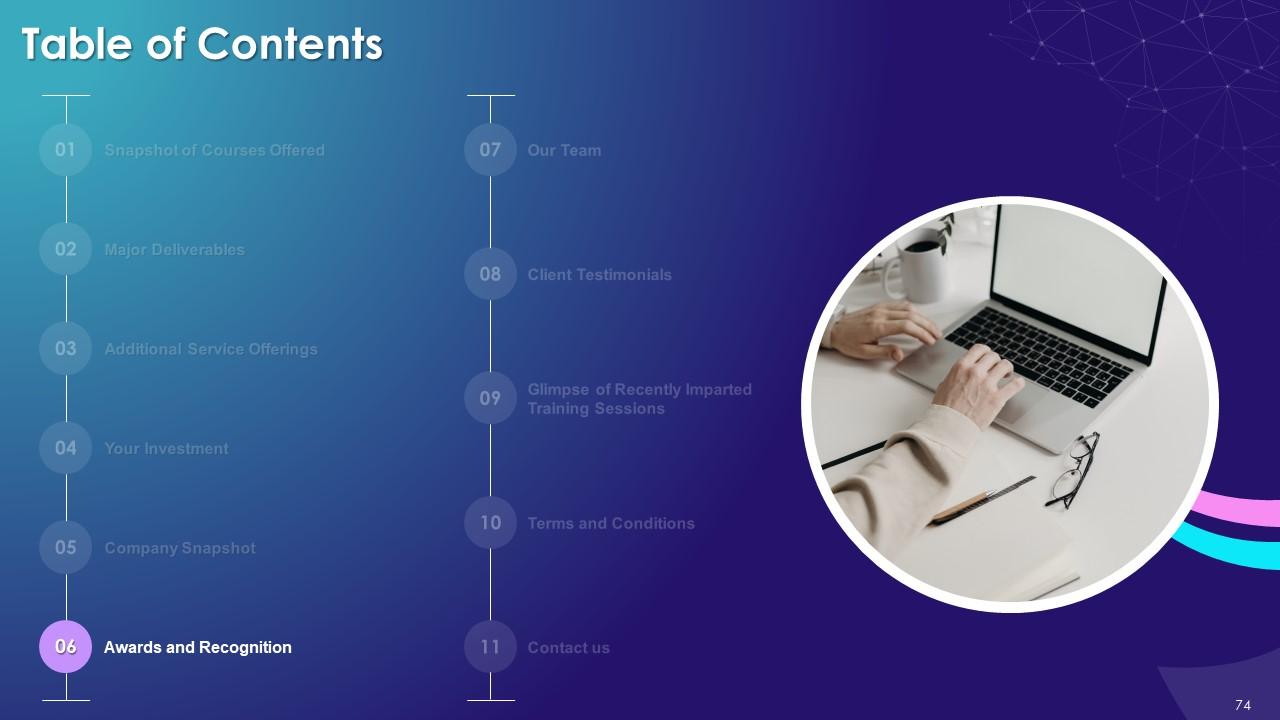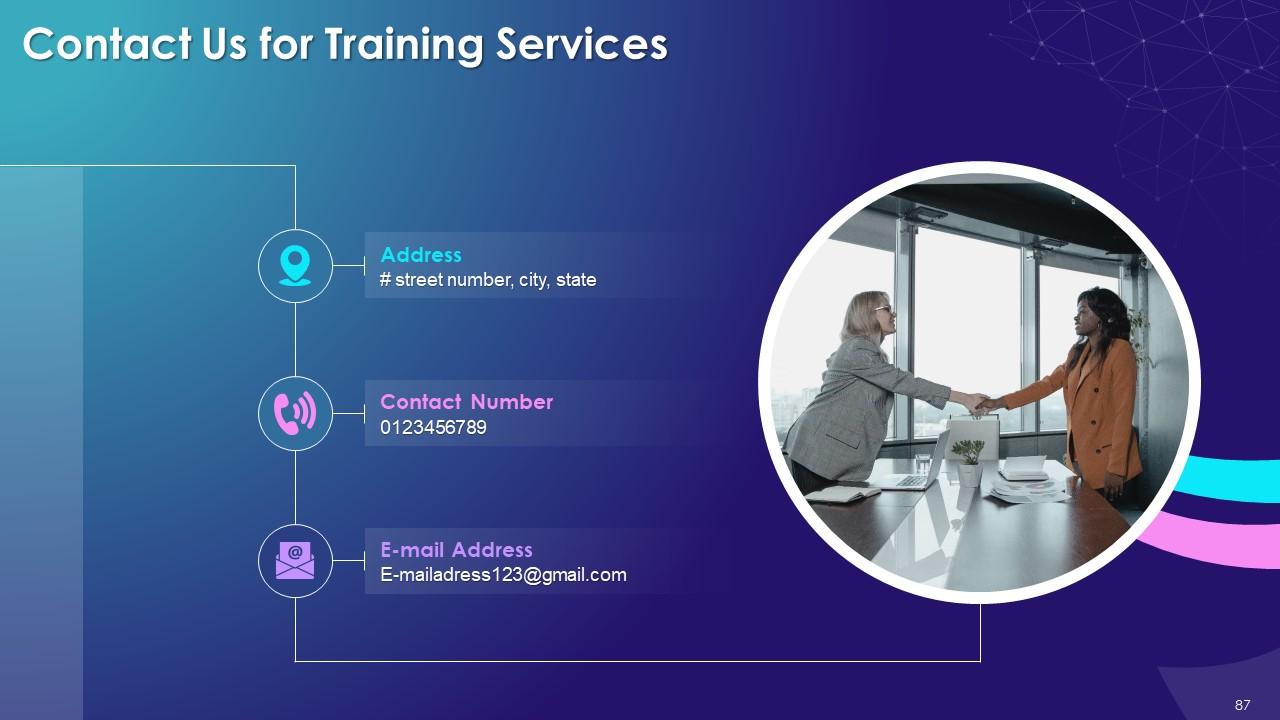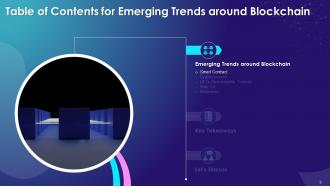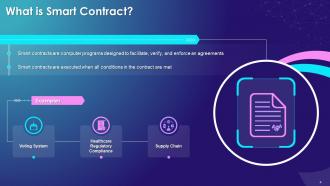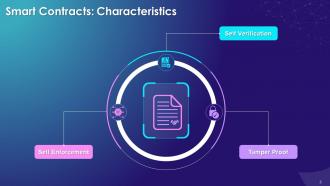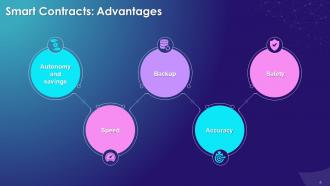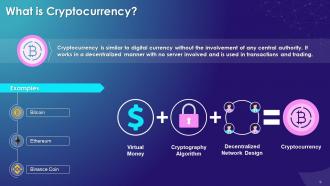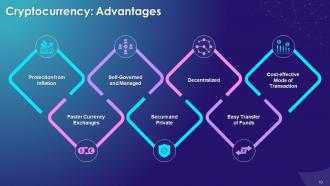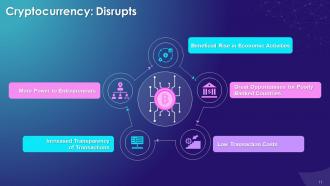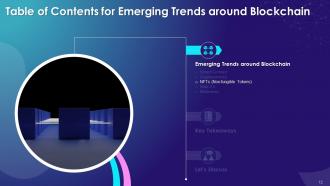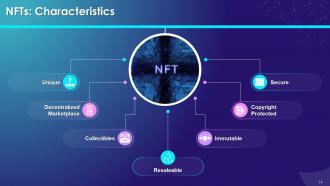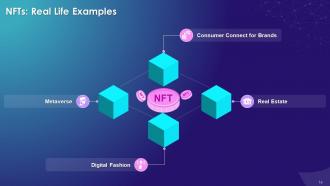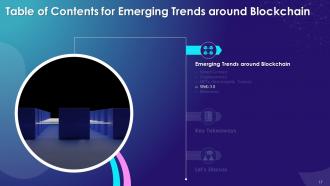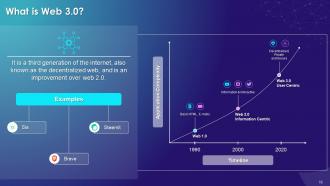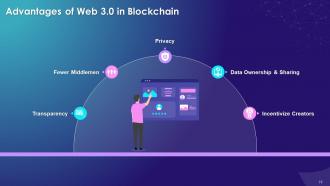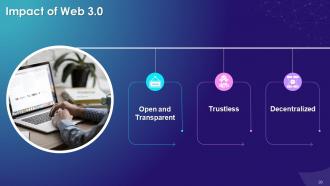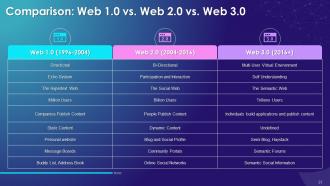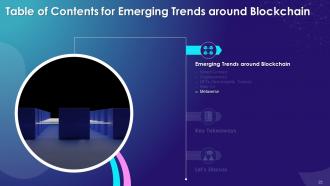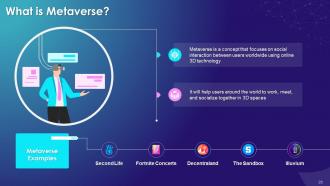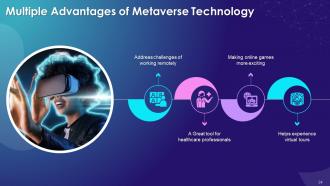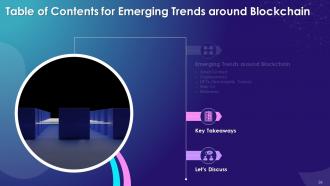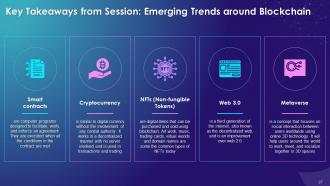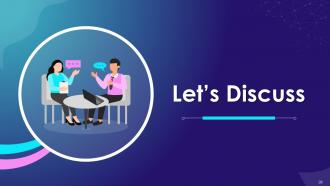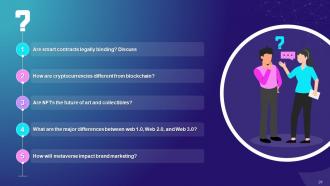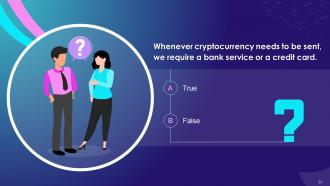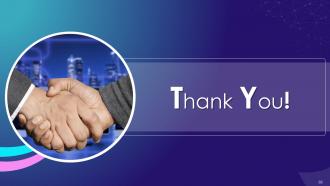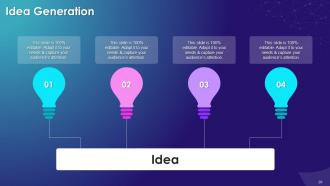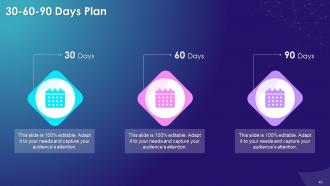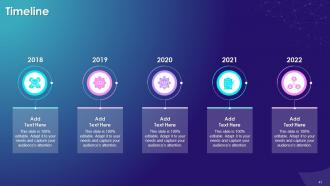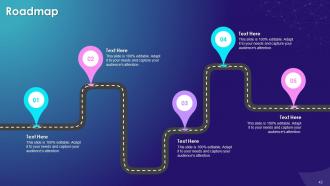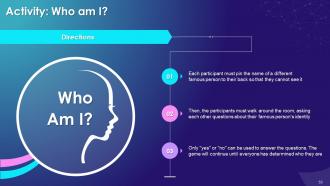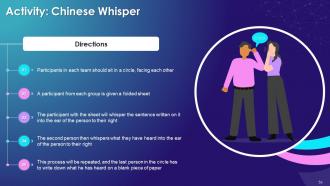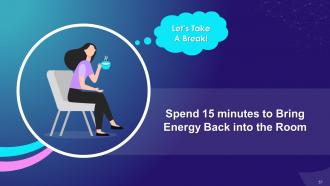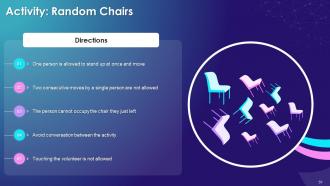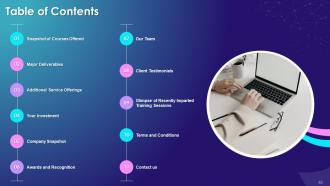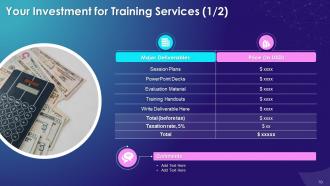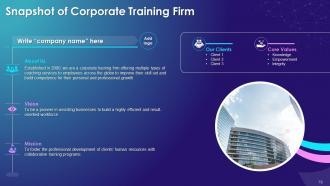Blockchain Emerging Trends Around Blockchain Training Module Training Ppt
This PPT training module covers the real-time applications of blockchain technology smart contracts, cryptocurrency, NFTs non-fungible tokens, Web 3.0, and the metaverse. It also contains key takeaways, discussion, and multiple-choice questions related to the topic to make the training session interactive. Further, it includes additional slides on about us, vision, mission, goal, 30-60-90 days plan, timeline, roadmap, training completion certificate, energizer activities, detailed client proposal, and training assessment form.
You must be logged in to download this presentation.
 Impress your
Impress your audience
Editable
of Time
PowerPoint presentation slides
Presenting Training Session on Emerging Trends around Blockchain. This presentation deck contains 90 well researched and uniquely designed slides. These slides are 100 percent made in PowerPoint and are compatible with all screen types and monitors. They also support Google Slides. Premium Customer Support available. Suitable for use by managers, employees and organizations. These slides are easily customizable. You can edit the color, text, icon and font size to suit your requirements.
People who downloaded this PowerPoint presentation also viewed the following :
Content of this Powerpoint Presentation
Slide 4
This slide illustrates the concept of smart contract in blockchain technology. It explains that they are computer programs that verify, facilitate, and enforce agreements. Smart contracts are executed when all conditions in the contract are met.
Slide 5
This slide showcases the different attributes of smart contract in blockchain technology such as self-enforcement, tamper-proof, and self-verification.
Instructor’s Notes:
The different characteristics of smart contracts are as follows:
Self-Enforcement:
- Smart contracts are independent and avoid any kind of human intervention
- The smart contract code is logic-based and requires a pre-agreed condition to unlock or access values
Tamper-Proof:
- In a smart contract, once the agreement is made and conditions are fulfilled, the agreement cannot be changed, which reduces the risk of manipulation of data in the network
- Any change in agreement can only be done by adding a new block to the existing chain with the consent of all users in the network
Self-Verification:
- In a smart contract, it is important to do self-verification with both parties in any agreement
- If there is an issue with the terms and conditions, both the parties can complain
- The parties can also penalize the offending party
- For e.g., in case a vendor delivers a product post the scheduled date, the smart contract can issue a refund automatically
Slide 6
This slide showcases advantages of smart contract in blockchain technology such as autonomy and savings, backup, safety, speed, and accuracy.
Instructor’s Notes:
The advantages of smart contracts in blockchain technology are as follows:
Autonomy and savings:
- In smart contracts, intermediaries are not required, eliminating the risk of manipulation which results in cost savings
Backup:
- In a smart contract, original data is available in the event of any data loss
- Thus, when any data need to be shared, all documents are stored in different blocks in the network
Safety:
- Smart contracts are encrypted, ensuring that documents that these relate to are protected against tampering or unauthorized use
Speed:
- It helps in saving time for different business processes by automating tasks with the use of computer protocols
Accuracy:
- Smart contracts help in eliminating errors that usually plague filling of multiple forms in the framing of contracts
Slide 7
This slide showcases different use cases in which smart contract contracts help industries. It also explains the work done by the role and the work that smart contracts play in industries such as financial services, life science and health care, technology, media, and telecom, energy and resources, public sector, and cross-industry.
Slide 9
This slide illustrates the concept of cryptocurrency in blockchain technology. It explains that a cryptocurrency helps in transactions and trading without any central authority involved in the blockchain network.
Slide 10
This slide illustrates the multiple benefits of cryptocurrency in blockchain technology such as protection from inflation, self-governed and managed, decentralized, cost-effective mode of transaction, faster currency exchanges, secure and private, and easy transfer of funds.
Instructor’s Notes:
The different advantages of cryptocurrency in blockchain technology are as follows:
Protection from Inflation:
- Due to inflation, the value of many currencies have declined
- Every cryptocurrency is released with a fixed set of quantity
- The source code specifies the total amount of coins e.g., Bitcoin has maximum 21million coins worldwide
- A limited amount of bitcoin increases its market value due to lower availability
Self-Governed and Managed:
- In cryptocurrency, transactions are stored, and developers/miners maintains these documents
- Each miner is rewarded based on their contribution to the process
- The information is being stored accurately because the miners are getting paid, keeping the integrity of the cryptocurrency and records decentralized
Decentralized:
- Decentralization helps ensure that currency can never be monopolized
- Bear in mind, developers are controlling these currencies at the time of their release
- With the help of decentralization, it is possible to restrain the flow and worth of coins from being controlled by a single organization or individual that will keep the coins stable and secure
Cost-effective mode of Transaction:
- Banks charge a certain percentage of fees on each transaction, whether domestic or international
- Cryptocurrency helps transfer the money from one place to another with negligible or zero transaction fees during the transaction
- Crypto does this by passing the third parties like VISA or PayPal, which banks were using to verify transactions
Currency Exchanges Finish Smoothly:
- Cryptocurrency helps citizens of any country around the world in transferring money across borders with no issues of foreign currencies and minimal transaction fees
Secure and Private:
- The blockchain ledger works on mathematical puzzles that are difficult to decode, making cryptocurrency safer than ordinary transactions
Easy Transfer of Funds:
- Due to fewer barriers in the transaction process for domestic or international money transfers, the transaction process takes less time to transfer the money in the form of cryptocurrency
Slide 11
This slide illustrates multiple disruptions that cryptocurrency has led to or will soon enable such as beneficial rise in economic activities, great opportunities for poorly banked countries, low transaction costs, increased transparency of transactions, and more power to entrepreneurs.
Instructor’s Notes:
The multiple disruptions caused by cryptocurrency in blockchain technology are as follows:
Beneficial Rise in Economic Activities:
- Cryptocurrency is a major growth engine for financial services industry across the world.
- The success rate of cryptocurrency has given handsome reward for early adopters
- Bitcoin helped many organizations develop and flourish, and some of them rely on trading as their primary source of income
- The world economy is slowly shifting to adapt to these needs, and cryptocurrency has great potential to fulfill the needs of these economic organizations
Great Opportunities for Poorly Banked Countries:
- Many people who lack access to financial channels will benefit from cryptocurrency
- Many apps could help these people use cryptocurrency, integrating them to the mainstream economy
- Also, the cryptocurrency works on a decentralized system, so it is easy trade financially without any disturbance from the central authority
Low Transaction Costs:
- The cryptocurrency and blockchain do not require any offline brick-and-mortar building to exist
- The costs associated with the transactions done in blockchain and cryptocurrency are minimal
- These activities inspire confidence among ordinary citizens to trust and participate in these financial tools
Increased Transparency of Transactions:
- Blockchain and cryptocurrency transactions are automated and digitized
- These transactions are tracked through a distributed ledger, which helps users to have full transparency, and it also helps to minimize the risk of fraud and corruption in the network
- The underdeveloped countries can benefit from this cryptocurrency system by changing the financial transaction process
- When adopted, citizens of these countries can track the transaction process in the network
More Power to Entrepreneurs:
- Cryptocurrency aims to help small businesses grow financially by easily converting the currency from one part of the world to another
- By using different wallets, the entrepreneurs can quickly convert their altcoins into fiat currency
- These transactions can later be directed to different business investments
- Due to the rapid improvements in cryptocurrency, millions of people will have the opportunity to invest and transfer money in a better, while also tracking the money flow into the system
Slide 13
This slide illustrates the concept of NFTs in blockchain technology. It explains that NFTs are digital items use blockchain to be bought and sold. They are non-fungible and are considered as unique asset. Art Work, Music, Trading Cards, Virtual Worlds and domain names are some the common types of NFTs today.
Slide 14
This slide showcases multiple benefits of NFT in blockchain technology such as decentralized marketplace, unique, collectibles, resaleable, immutable, copyright protected, and secure.
Instructor’s Notes:
The different advantages of NFT in blockchain technology are as follows:
Decentralized marketplace:
- NFT is an excellent platform for creators to sell their work to customers. This is due to the fact that blockchain eliminates intermediaries and makes this possible.
- Another benefit of NFT is that it helps creators earn a commission, each time an NFT is exchanged
Unique:
- Each NFT is unique and cannot be easily forged
- The creator will have a handful of NFTs, and very few creators will own and limit these, which increases the value of each NFT
Collectibles:
- NFTs are collectibles because they are unique, and buyers can hold on to them upon buying them as their value will increase over time
Resaleable:
- People use NFTs to make money by buying and reselling them
- Investing in NFTs and then reselling them is, potentially, a huge profit opportunity
Immutable:
- The NFTs are immutable because the metadata can never be altered by anyone
- Also, it cannot be erased, misplaced, or removed from the blockchain
- The data lasts forever, and its value will (most likely) increase with time
Copyright:
- In NFTs technology, the most significant advantage is that it allows users and content creators to retain their complete copyrights
- Users generate revenue without giving up their copyrights
Security:
- In NFTs, security is not an issue
- The blockchains are decentralized, and the data they hold is hosted in different nodes around the globe
- If the network is down, the record of each node is registered somewhere
Slide 15
This slide illustrates multiple disruptions that NFTs causes in industries such as music industry, art industry, sports industry, and gaming industry.
Instructor’s Notes:
The multiple disrupts that NFTs have caused are as follows:
Music Industry:
- In music, NFTs will become a platform to store music on a digital ledger as a rare collectible
- Artists and musicians can create NFTs to auction their music in different forms of digital media to their listeners
- Listeners can pay for the content by using cryptocurrencies like Bitcoin, Ethereum, and many others
Collectibles:
- These are the items of values that collectors acquire in the form of NFTs
- These items can be purchased and sold as NFTs on higher values as they are limited-edition
- The collectors can be short-term gain hunters to crypto magnates
- The category includes:
- Game collectibles
- Art collectibles
- Sports collectibles
NFTs for Land Ownership/Claims:
- Land assets can be represented as NFTs, and their ownership can be proven by using cryptographically secured and signed digital tokens
- With the help of smart contracts, money and land asset exchange can be done in an authentic manner, with both parties signing the agreement
Art Industry:
- The art industry is huge. Converting the art into NFTs provides the creator with the ability to own and trade it
- NFT helps the artists earn revenue by selling the arts, eliminating the intermediaries, and facilitating direct interaction between
Sports Industry:
- The NFT has changed the sports industry completely
- A athletes can now establish their own brand identity and sell them by making NFTs
- These NFTs can sell for millions of dollars
- The potential of earning money and making their brand has increased with the help of NFTs
Internet of Things (IOT):
- NFTs act as a device authenticator to secure IOT networks, which prevents a single user from controlling the massive amount of data that digital networks generate
Gaming Industry:
- In a game, players use their real money to buy items that could help them in playing and have better playing experience
- If the players delete or stop playing the game and move on to the next game, the purchased game items also get lost, thus resulting in wasting money used in the purchase
- The NFTs help players restore the money by selling the items to the other players in the form of reward points that can be used in other games to purchase new items
Slide 16
This slide showcases different use cases in which NFTs helped different users. It explains the use cases of NFTs such as consumer connect by Coca-Cola, real estate, metaverse, and digital fashion.
Instructor’s Notes:
The multiple use cases of NFTs are as follows:
Consumer connect by Coca Cola:
- Coca-Cola is one of the top brands to enter the domains of NFTs
- The company issued the vintage collectibles of Coca-Cola bottles
- The company collected around $575,000 for vintage collectibles in an online auction
- This shows that companies can use NFTs as a way to connect with consumers and earn revenue
Real Estate:
- The IPwe and IBM collaborated for transforming corporate patents
- With the help of NFTs, these organizations help create an ecosystem to make patents tokenized to enable the commercialization, licensing, and sales of patents
Metaverse:
- Social media companies such as Facebook use metaverse technology to enable users in socializing, interacting, and building the virtual world with digital avatars
- NFTs helps the social media companies in a unique way to create avatars in digital worlds
- The uniqueness of avatars would determine their values
Digital Fashion:
- Luxury brands such as Louis Vuitton, Gucci have shown confidence in the potential of using NFTs to promote their products
- These brands want to leverage NFTs to promote their brand
- NFTs also help in maintaining the authenticity of the product, allowing customers to purchase the original product
Slide 18
This slide illustrates the concept of web 3.0 in blockchain technology. It explains that web 3.0 is the third generation of the internet, also known as decentralized web which is an enhancement over web 2.0.
Slide 19
This slide highlights the multiple benefits of web 3.0 in blockchain technology such as transparency, fewer middlemen, privacy, data ownership & sharing, and incentivize creators.
Instructor’s Notes:
The different advantages of web 3.0 in blockchain technology are as follows:
Transparency:
- The major advantage of web 3.0 is that the users can track their data and analyze the user's source code
- Non-profit organizations create the most important blockchain-based platform
Fewer Middlemen:
- The decentralization platform promises to connect companies directly with the customers, and no third parties will be involved or will receive any share from the business
- It is not possible to remove all the intermediaries with the use of blockchain network, Hence, there is still the need for adequate regulations and a system to monitor that fairness is maintained across all users
Privacy:
- In web 3.0, the blockchain allows users to protect and monitor their information
Data Ownership & Sharing:
- Web 3.0 provides the user with a profile that is private and can be used across platforms
- If the user wants to share or sell their data to the brands or advertisers, it can be shared easily as the authenticity of the data has already been checked
Incentivize Creators:
- Web 3.0 helps users with new business ideas to connect with the major organizations to work together
- Due to elimination of intermediaries through the blockchain network, any user can establish business and connect directly with customers
Slide 20
This slide showcases the multiple impacts of web 3.0 that will help to bring in the business such as open or transparent, trustless, and decentralized.
Instructor’s Notes:
The multiple impacts of web 3.0 are as follows:
Open or Transparent:
- The openness of web 3.0 will ensure that any program built in the network will be accessible to a community of developers on the internet
- The development and deployment of such programs are done in a transparent manner
- Open-source programs are virtual resources and should be available to any user who can leverage its benefits
Trustless:
- A trustless network ensures that no intermediary will be involved in online transactions or interactions
- In the blockchain, all transactions involving cryptocurrencies are done only with the participation of individuals that are a part of the network
- Only the buyer and seller are connected in a peer-to-peer network, and no intermediary is involved in the transaction
Decentralization:
- Web 3.0 will be more secure and decentralized as it will secure data at multiple locations globally to eliminate the threat of data loss from the network
Slide 21
This slide illustrates the comparison between web 1.0, 2.0, 3.0. They are compared on parameters like ecosystem, web type, user count, content creation, content type, platforms used, and communication channels.
Slide 23
This slide highlights the concept of metaverse in blockchain technology. It explains that metaverse focuses on social interaction between users worldwide using online 3D technology. It also helps users around the world to work, meet, and socialize together in 3D spaces.
Slide 24
This slide highlights the multiple advantages of metaverse technology such as addressing remote work challenges, a great tool for healthcare professionals, making online games more exciting, and providing the experience of virtual tours.
Instructor’s Notes:
The different advantages of metaverse technology are as follows:
Addressing the remote work challenges:
- It helps office employees to interact with their managers during remote work situations
- It also helps managers and their employees experience in-person interaction, which includes reading their body language
- Remote work problems like productivity, time theft and goldbrick can be resolved by keeping track of teams through unique avatars
A great tool for healthcare professionals:
- Metaverse can help healthcare professionals and medical staff treat patients without being physically present at the location
- It helps to get a clear insight into their health conditions
Making online games more exciting:
- Online gaming has been revolutionized with the introduction of a decentralized economic model in which developers and publishers own the in-game assets
- These users also have the right to distribute these assets within the game
- The gaming industry has become more exciting with the idea of allowing avatars to explore the vast virtual space in online games
Providing the experience of virtual tours:
- Metaverse allows people to visit places virtually
- With the combined power of metaverse, AR, VR, an advanced virtual world is being developed to offer a first-person experience to users
Slide 25
This slide showcases the multiple changes that metaverse will bring in the near future such as rise of digital real estate, e-commerce will merge with brick-and-mortar retail, advertising will move aggressively into the metaverse, turning video calls into reality, most business meeting will occur in the metaverse, and education will take place in classrooms inside the metaverse.
Instructor’s Notes:
The multiple changes metaverse is causing are as follows:
The Rise of “Digital Real Estate”:
- Different companies purchase real estate in metaverse as an online investment
- Some of the real estate in metaverse has been sold for millions of dollars
- This type of real estate is compared with the real world as people buy real estate, in areas believing that the area will prosper with time
E-Commerce Will Merge with Brick-And-Mortar Retail:
- In metaverse, the E-commerce industry will play a significant role in establishing the connection between the user and companies
- Different companies will establish their stores and sell items in the metaverse universe
- If the customer needs to buy some particular item, they will have to visit the virtual store of the company established in the metaverse universe
Advertising Will Move Aggressively into the Metaverse:
- The advancement of metaverse will help brands promote their products
- Different corporations will put the buildings in the metaverse, which will help the brands advertise their products and help users shop from metaverse stores
Turning Video Calls into Reality:
- With the help of metaverse, users can participate in 3D virtual meetings to interact with their family or office colleagues
- It will also enhance the possibilities for users to choose the place in the metaverse universe where they want to connect and experience private virtual video calls
Most Business Meetings Will Occur in the Metaverse:
- Working remotely has become a new norm worldwide
- Metaverse has enhanced the experience of working from outside, so there is no necessity to meet in-person for business or work-related meetings and discussions
- This will help companies that send employees for onsite projects in different countries save thousands of dollars
Education Will Take Place in Classrooms inside the Metaverse:
- 3D Virtual classrooms with metaverse technology will provide everything that a real classroom provides
- Students take notes with the help of a virtual pen that will give them real-life classroom experience
- Making the experience real-life, students will raise their hands and write on board if and when their teacher directs them to do so
Slide 27
This slide summarizes emerging trends around blockchain. The trainer can use it to highlight the essential concepts of the session to trainees.
Slide 45 to 59
These slides contain energizer activities to engage the audience of the training session
Slide 61 to 87
These slides contain a training proposal covering what the company providing corporate training can accomplish for the client.
Slide 88 to 90
These slides include a training evaluation form for instructor, content and course assessment.
Blockchain Emerging Trends Around Blockchain Training Module Training Ppt with all 95 slides:
Use our Blockchain Emerging Trends Around Blockchain Training Module Training Ppt to effectively help you save your valuable time. They are readymade to fit into any presentation structure.
-
Best way of representation of the topic.
-
It’s really cool, and you can find pretty much everything you could need for your work or school.





































